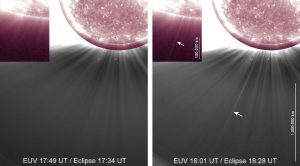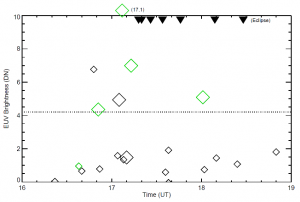Yoichiro Hanaoka (NAOJ)
Solar coronal jets have been extensively studied using soft X-ray and extreme-ultraviolet (EUV) data, and they are understood as common phenomena in the low corona. However, from soft X-ray and EUV observations alone, it is difficult to know how high the jets extend. One reason is that there is a gap in the height coverage of the corona by the spaceborne instruments.
At the total solar eclipses, we can observe the corona from the limb to several solar radii under the very low sky background level. At the eclipse on 2017 August 21, we organized a multi-site observation program, and succeeded in taking a time-series of wide dynamic range images of the white-light corona at seven sites during a time period of about 70 minutes. Such observations enabled us to trace the time variation of the corona beyond the height coverage by the spaceborne instruments.
In the eclipse data, we found coronal jets, which are seen as upwardly ejected narrow structures in polar plumes. Figure 1 shows an example of the eclipse jets also observed in the EUV. The right panel shows that an EUV jet observed with the AIA of the SDO appeared at 18:01 UT extending about 100,000 km, and at 18:28 UT, the jet appeared in the eclipse image and it extended beyond 1,000,000 km. This jet is presumed to escape from the Sun to the solar system. Six jets were found in the polar coronal hole regions, and all of them extend from the solar surface to beyond 2 Rsun. Their average apparent speed of extension is about 450 km s-1. All of the eclipse jets were preceded by EUV jets, and conversely, all the EUV jets whose brightness is comparable to ordinary soft X-ray jets and which occurred in the polar regions near the eclipse period were observed as eclipse jets, as shown in Figure 2. These results suggest that ordinary polar jets generally reach high altitudes and escape from the Sun as part of the solar wind, while so far it has been known that only highly energetic jets in the polar regions sometimes reach high altitudes in the corona. (The EUV images were provided by courtesy of NASA/SDO and the AIA science team.)
Hanaoka et al. 2018, “Solar Coronal Jets Extending to High Altitudes Observed During the 2017 August 21 Total Eclipse”, Astrophysical Journal 860, 142 (DOI:10.3847/1538-4357/aac49b)

Figure 1. EUV images at 211 Å taken with the AIA of the SDO and eclipse white-light images before (left) and after (right) the occurrence of a jet. An enlargement of the EUV image in the box is shown at the upper-left corner for each panel. The white-light images are processed to suppress the steep radial brightness gradient and to enhance the jet.

Figure 2. Brightness of the EUV 211 Å jets observed in the polar regions around the eclipse time period plotted at their peak times. Many EUV jets were found, and among them the jets accompanied by the eclipse jets are displayed with large symbols, and those also observed in the soft X-rays are shown with green symbols. The eclipse observation epochs are marked with triangles.
